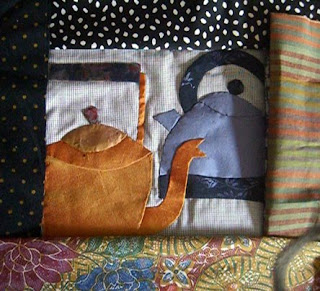 In Wednesday Afternoon ("a minor masterpiece of poetic discretion", says the New York Times) "a male narrator with a neutral mid-Atlantic inflection ["an anonymous Canadian" - who better?] muses on the experience of the contemporary museum visit. Accompanied by a sequence of lingering shots of artefacts and interiors from the British and Victoria & Albert Museums ranging from the Elgin Marbles to casually dressed visitors - the narrator comments he is 'less interested in endless amounts of stuff pressing into the moment than in the unforeseen combinations of objects and people, the lashes of feeling, the semiotics of tourist leisurewear'." - so says the leaflet accompanying the exhibition.
In Wednesday Afternoon ("a minor masterpiece of poetic discretion", says the New York Times) "a male narrator with a neutral mid-Atlantic inflection ["an anonymous Canadian" - who better?] muses on the experience of the contemporary museum visit. Accompanied by a sequence of lingering shots of artefacts and interiors from the British and Victoria & Albert Museums ranging from the Elgin Marbles to casually dressed visitors - the narrator comments he is 'less interested in endless amounts of stuff pressing into the moment than in the unforeseen combinations of objects and people, the lashes of feeling, the semiotics of tourist leisurewear'." - so says the leaflet accompanying the exhibition.Apart from the thought-provoking commentary, it was pleasurable to see scenes and artefacts and think "I know where that is" and "gosh, must get back there soon and look at that again".
What better way to "kill time" by wandering around museums -- places that transcend time.
Similar simultaneity, and other opportunities for using time in unscheduled ways, exists on (in?) the internet. Where to wander, what to look at? Click on a link and be surprised ... thus it was that "The Birth of Adam" by prolific Israeli artist Ron Gang caught my eye -
 Another kind of aimlessly creative looking happens in magazines. I photographed these in the Tate Britain shop because of wanting to remember to look up the artists, Dod Proctor (1892-1972, worked mainly in Newlyn, Cornwall) here -
Another kind of aimlessly creative looking happens in magazines. I photographed these in the Tate Britain shop because of wanting to remember to look up the artists, Dod Proctor (1892-1972, worked mainly in Newlyn, Cornwall) here - and several of the ceramicists listed on the cover of Ceramic Review -
and several of the ceramicists listed on the cover of Ceramic Review - You can see Carolyn Genders' work here.
You can see Carolyn Genders' work here.If you keep your eyes open, you never know what you'll see. A few days ago, this postcard was lying in the street, waiting to be rescued:
 The painting is called Meadow and it's by Kitty Stirling (another of her works can be seen here). "Meadow" seems to cry out for some stitches in the foreground....
The painting is called Meadow and it's by Kitty Stirling (another of her works can be seen here). "Meadow" seems to cry out for some stitches in the foreground....












































